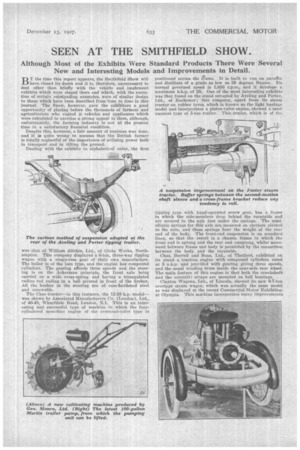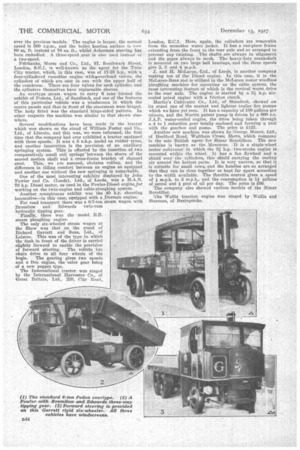SEEN AT THE SMITHFIELD SHOW.
Page 61

Page 62

If you've noticed an error in this article please click here to report it so we can fix it.
Although Most of the Exhibits Were Standard Products There Were Several New and Interesting Models and Improvements in Detail.
Y the time this report appears, the Smithfield Show will -I--)have closed its doors and it is, therefore, unnecessary to deal other than briefly with the vehicle and .implement exhibits which wtre staged there and which, with the exception of certain outstanding examples, were of similar design to those which have been described from time to time in this journal. The Show, however, olive the exhibitors a good opportunity of placing before the thousands of farmers and agriculturists who visited it vehicles and appliances which were calculated to exercise a strong appeal to them, although, unfortunately, the farming industry is not at the present time in a satisfactory financial condition.
Despite this, however, a fair amount of business was done, and it is quite wrong to assume that the British farmer is totally neglectful of the importance of utilizing power both in transport and in tilling the greund.
Dealing with the exhibits in alphabetical order, the first
was that of William Alichin, Ltd., of Globe Works, Northampton. This company displayed a 6-ton, three-way tipping wagon with a singe-ram gear of their own manufacture. The boiler is of the loco type, and the engine has compound cylinders. The gearing affords three sPeeds and the steering is on the Ackerman principle, the front axle being carried on a wide cross-spring and having a triangulated radius rod .ending in a ball pivoted in front of the firebox. All the bushes in the steering are of case-hardened steel and renewable.
The Case tractor—in this instance, the 12-20 h.p. Model— was shown by Associated Manufacturers Co. (London), Ltd., of 46-48, Wharfdale Road, London, NJ. This is an interesting and successful type of machine in which the fourcylindered monobloe engine of the overhead-valve type is Positioned across the ittme. It is built to run on paraffin and distillate of a grade as low as ilP degrees Bautne. Its normal governed speed is 1,050 r.p.m., and it develops a maximum b.h.p. of 25. One of the most interesting exhibits was that found on the stand occupied by Aveling and Porter, Ltd., of Rochester; this company, apart from its steam tractor on rubber tyres, which is known as the light haulage model and incorporates a piston-valve engine, showed a most unusual type of 5-ton trailer. This trailer, which is of the tipping type with hand-operated screw gear, has a frame ill which the side-members drop behind the turntable and are secured to the axle just under the springs, The semi• elliptic springs for this axle are mounted on carriers pivoted to the axle, and these springs bear the weight of the rear end of the body. The front-end suspension is on standard lines, SO that the result is a chassis frame in which the front end is sprung and the rear end unsprung, whilst movement between frame and body is permitted by the connection between the body and the turntable.
Chas. Burrell and Sons, Ltd., of Thetford, exhibited on its stand. a traction engine with compound cylinders rated at 5 n.h.p. and provided with gearing giving three speeds, and the usual winding drum inside the near-side rear wheel. The main feature of this engine is that both the crankshaft and the eccentric straps are mounted on ball bearings. .
Clayton Wagons, Ltd., of Lincoln, showed its new 6-7-ton evertype steam wagon, which was actually the same model as was displayed at the recent Commercial Motor Exhibition at Olympia. This machine incorporates many improvements over the previous models. The engine is larger, the normal speed is 500 r.p.m., and the boiler heating surface is now 90 sq. ft. instead of 70 sq. ft., whilst Ackerman steering has been embodied. A three-speed gear is also Used instead of a two-speed.
Fairbanks, Morse and Co., Ltd., 87, Southwark Street, London, &E.1, Is well-known as the agent for the Twin City tractor, which, in this case, was of 17-28 h.p., with a fourcylindered rionobloc engine withooverhead valves, the cylinders of which are east in one with the upper half of the crankcase. There are four valves for each cylinder, and the cylinders themselves have replaceable sleeves.
An overtype steam wagon to carry 6 tons formed the exhibit of Podens, Ltd., of Sandbach, and one of the features of this particular vehicle was a windscreen in which the centre panels and that in front of the steersman were hinged. The body fitted was the standard hinge-sided pattern. In other respects the machine was similar to that shown elsewhere.
Several modifications have been made in the tractor which was shown on the stand of William Foster and Co., Ltd., of Lincoln, and this was, we were informed, the first time that the company had over exhibited a tractor equipped with three speeds. It was a 5 n.h.p. model on rubber tyres, and another innovation is the provision of an auxiliary springing system. This is effected by the insertion of two comparatively small coil springs between the sleeve of the second motion shaft and a cross-frame bracket of channel
steel. This, we bre assured, obviates rolling, and the difference in riding comfort between an engine so equipped and another one without the new springing is remarkable.
One of the most interesting exhibits displayed by John Fowler and Co. (Leeds), Ltd., of Leeds, was a M.A.N. 70 h.p. Diesel motor, as used in the Fowler-DieseI enginejor working on the twin-engine and cable-ploughing system. Another conspicuous exhibit was the 40 h.p. shunting locomotive—in this case, equipped with a Dorman engine. For road transport there was a 6-7-ton steam wagon with Bromilow and Edwards twin-ram hydraulic tipping gear. Finally, there was the model B.B. steam ploughing engine.
The only six-wheeled steam wagon at the Show was that on the stand of Richard Garrett and Sons, Ltd., of Leiston. This was of the type in which the dash in front of the driver is carried slightly forward to enable the provision of forward steering. The vehicle has chain drive to all four wheels of the bogie. The gearing gives two speeds and a free engine, the valve gear being of a new poppet type.
The International tractor was staged by the International Harvester Co., of Great Britain, Ltd., 259, Oily Road, London, E.C.1. rere, again, the cylinders are removable from the monobloe water jacket. It has a one-piece frame extending from the front to the rear axle and so arranged to prevent any twisting. . The shafts are always in alignment and the gears always in mesh. The heavy-duty crankshaft is mounted on two large ball bearings, and the three speeds give 2, 3 and 4 m.p.h.
J. and H. McLaren, Ltd., of Leeds, is another company making use of the Diesel engine. In this case, it is the McLaren-Benz and is utilized in the 1VIcLaren motor windlass ploughing machine for operating on the cable system, the most interesting feature of which is the vertical worm drive to the rear axre. The engine is started by a 3i h.p. aircooled petrol engine with a friction clutch.
Martin's Cultivator Co., Ltd., of Stamford, showed on its stand one of the neatest and lightest trailer fire pumps which we have yet seen. It has a capacity of 100 gallons per minute, and the Martin patent pump is driven by a 600 c.c. J.A.P. water-cooled engine, the drive beinob taken through a 4 to 1 reduction gear totally enclosed and forming a unit with the gearbox and pump. The price is £125.
Another new machine was shown by George Monro, Ltd., of Hertford Road, Waltham Cross; Hefts, which company is the sole British agent. for Simar Rototillers. The new machine is known as the Monotrac. It is a single-wheel motor cultivator in which the 3i h.p. two-stroke engine is mounted within the wheel. It has a fan flywheel and a shield over the cylinders, this shield carrying the cooling air around the hottest parts. It is very narrow, so that it is suitable for small rows, and the handles are so arranged that they can be close together or kept far apart according to the width available, The throttle control gives a speed of m.p.h. to 3 m.p.h., and the consumption is 13 gallons of petrol and pint of oil per day. The price is £60.
The company also showed various models of the Simar Rototiller.
• t.l.'he Wallis traction engine was staged by Wallis and Steevens, of Basingstoke.




































































































